Visiting Tu Lou - Hakka's Earth Buildings
A group of us, consisting of 20 High Five Youth awardees, 10 Life Inspiration Award winners and 7 officials from Central Singapore CDC, went to the city of Xiamen ( 厦门 ), China on an exchange programme in June 2004. I went with them as one of the officials.
@ S'pore Consulate... Meeting Deputy Mayor
With S'pore Club M'bers
Besides visiting Singapore's Consulate in Xiamen, community centres, an
orphanage, a home for the elderly, YMCA, the University for the Elderly (老人大学) and some 3-generation families, we also visited the inimitable Hakka Tu Lou (客家土楼) in Yongding County ( 永定县). Tulou is a Chinese name meaning Earth Building.
The bus journey from the city of Xiamen to the earth buildings in Yongding County took about 5 hours. Travelling along the fertile plains of south Fujian (福建), we saw endless stretches of vegetable and fruit farms, dotted with well-built wooden and brick houses. But as we entered the mountainous region of Yongding, the farms gave way to rugged and rocky terrains, and the roads were narrow and winding.
During the long bus ride, the local tour guide entertained us with interesting stories about the province of Fujian, particularly about the wars over Taiwan, the conflicts and intrigues among the warlords towards the end of Manchu Dynasty. We were also fascinated by his narration of how the Hakkas (客家人), as early as 1,000 years ago, due to wars and persecutions, started to migrate from the central regions of China to Fujian and Guandong (广东) in the south. As poor migrants they had to work extremely hard to survive and build their new homes. Life was hard for them because the good and fertile plains had already been occupied by the locals who of course resented their intrusion. Being unwelcome, they had no alternative but to move into the mountains. To survive, they banded together and devised ways to defend and protect themselves. The earth buildings were therefore designed not for aesthetic reasons, but for protection from the elements, and for defence against wild animals, thieves and bandits
migrants they had to work extremely hard to survive and build their new homes. Life was hard for them because the good and fertile plains had already been occupied by the locals who of course resented their intrusion. Being unwelcome, they had no alternative but to move into the mountains. To survive, they banded together and devised ways to defend and protect themselves. The earth buildings were therefore designed not for aesthetic reasons, but for protection from the elements, and for defence against wild animals, thieves and bandits
The tour guide also told us that some years ago, some American satellite photos picked up the pictures of these Hakka Tulous and thought that they were China's nuclear reactors hidden in the mountainous regions of Fujian. Greatly alarmed, some US military liaison officers stationed at the American Embassy in Beijing were sent down to Yongding to investigate. They found to their relief and embarrassment that what they thought were nuclear reactors or missile silos were in fact harmless earth buildings where the Hakkas had been living for centuries!
pictures of these Hakka Tulous and thought that they were China's nuclear reactors hidden in the mountainous regions of Fujian. Greatly alarmed, some US military liaison officers stationed at the American Embassy in Beijing were sent down to Yongding to investigate. They found to their relief and embarrassment that what they thought were nuclear reactors or missile silos were in fact harmless earth buildings where the Hakkas had been living for centuries!
Since the discovery of the earth buildings by the American satellite, word of these unique buildings began to spread far and wide, resulting in thousands of tourists from all over the world coming to Fujian to take a look at the buildings, particularly the Japanese tourists.
 We arrived at our destination: Zhencheng Lou (振成楼) at about 3.00pm. I was given a small room on the top (4th) floor with a wooden bed. Furnishings were less than basic: a very thin mattress, a blanket, a pillow and a stool. There were no tables, mirror or wardrobe, and water can only be
We arrived at our destination: Zhencheng Lou (振成楼) at about 3.00pm. I was given a small room on the top (4th) floor with a wooden bed. Furnishings were less than basic: a very thin mattress, a blanket, a pillow and a stool. There were no tables, mirror or wardrobe, and water can only be found on the ground floor. I found a small plastic pail in a corner and later I was told that it was meant for me to use at night so that I need not have to go down all the way from the fourth level to the first level, open the big door and grope my way to the toilets located a distance away.
found on the ground floor. I found a small plastic pail in a corner and later I was told that it was meant for me to use at night so that I need not have to go down all the way from the fourth level to the first level, open the big door and grope my way to the toilets located a distance away.
I did not have a bath that day except to clean myself with a pail of well water and a face towel. Some who wanted to have a bath had to queue up for their turn outside the bathroom ( there was only one decent one). In the bathroom, they had to wait a long time to fill up your small wooden tub with water!. Was there hot water for bathing? Hot water? You must be joking!
 The owner of this Tulou doubled as our tour guide. He gave us a short
The owner of this Tulou doubled as our tour guide. He gave us a short  description of his Earth Building named Zhencheng Lou. It was built in 1912 by a rich Hakka for his clan. The walls of the Tulou were made impregnable with rammed earth and sandstone mixed with bamboo, brown sugar and sticky rice. Each wall is 1 metre thick and about 18 metres tall. There is only one door and the windows are small and found only on the higher floors. Most of the Tulous are round, square or rectangular.
description of his Earth Building named Zhencheng Lou. It was built in 1912 by a rich Hakka for his clan. The walls of the Tulou were made impregnable with rammed earth and sandstone mixed with bamboo, brown sugar and sticky rice. Each wall is 1 metre thick and about 18 metres tall. There is only one door and the windows are small and found only on the higher floors. Most of the Tulous are round, square or rectangular.
During the long bus ride, the local tour guide entertained us with interesting stories about the province of Fujian, particularly about the wars over Taiwan, the conflicts and intrigues among the warlords towards the end of Manchu Dynasty. We were also fascinated by his narration of how the Hakkas (客家人), as early as 1,000 years ago, due to wars and persecutions, started to migrate from the central regions of China to Fujian and Guandong (广东) in the south. As poor
 migrants they had to work extremely hard to survive and build their new homes. Life was hard for them because the good and fertile plains had already been occupied by the locals who of course resented their intrusion. Being unwelcome, they had no alternative but to move into the mountains. To survive, they banded together and devised ways to defend and protect themselves. The earth buildings were therefore designed not for aesthetic reasons, but for protection from the elements, and for defence against wild animals, thieves and bandits
migrants they had to work extremely hard to survive and build their new homes. Life was hard for them because the good and fertile plains had already been occupied by the locals who of course resented their intrusion. Being unwelcome, they had no alternative but to move into the mountains. To survive, they banded together and devised ways to defend and protect themselves. The earth buildings were therefore designed not for aesthetic reasons, but for protection from the elements, and for defence against wild animals, thieves and banditsThe tour guide also told us that some years ago, some American satellite photos picked up the
 pictures of these Hakka Tulous and thought that they were China's nuclear reactors hidden in the mountainous regions of Fujian. Greatly alarmed, some US military liaison officers stationed at the American Embassy in Beijing were sent down to Yongding to investigate. They found to their relief and embarrassment that what they thought were nuclear reactors or missile silos were in fact harmless earth buildings where the Hakkas had been living for centuries!
pictures of these Hakka Tulous and thought that they were China's nuclear reactors hidden in the mountainous regions of Fujian. Greatly alarmed, some US military liaison officers stationed at the American Embassy in Beijing were sent down to Yongding to investigate. They found to their relief and embarrassment that what they thought were nuclear reactors or missile silos were in fact harmless earth buildings where the Hakkas had been living for centuries!Since the discovery of the earth buildings by the American satellite, word of these unique buildings began to spread far and wide, resulting in thousands of tourists from all over the world coming to Fujian to take a look at the buildings, particularly the Japanese tourists.
 We arrived at our destination: Zhencheng Lou (振成楼) at about 3.00pm. I was given a small room on the top (4th) floor with a wooden bed. Furnishings were less than basic: a very thin mattress, a blanket, a pillow and a stool. There were no tables, mirror or wardrobe, and water can only be
We arrived at our destination: Zhencheng Lou (振成楼) at about 3.00pm. I was given a small room on the top (4th) floor with a wooden bed. Furnishings were less than basic: a very thin mattress, a blanket, a pillow and a stool. There were no tables, mirror or wardrobe, and water can only be found on the ground floor. I found a small plastic pail in a corner and later I was told that it was meant for me to use at night so that I need not have to go down all the way from the fourth level to the first level, open the big door and grope my way to the toilets located a distance away.
found on the ground floor. I found a small plastic pail in a corner and later I was told that it was meant for me to use at night so that I need not have to go down all the way from the fourth level to the first level, open the big door and grope my way to the toilets located a distance away.I did not have a bath that day except to clean myself with a pail of well water and a face towel. Some who wanted to have a bath had to queue up for their turn outside the bathroom ( there was only one decent one). In the bathroom, they had to wait a long time to fill up your small wooden tub with water!. Was there hot water for bathing? Hot water? You must be joking!
 The owner of this Tulou doubled as our tour guide. He gave us a short
The owner of this Tulou doubled as our tour guide. He gave us a short  description of his Earth Building named Zhencheng Lou. It was built in 1912 by a rich Hakka for his clan. The walls of the Tulou were made impregnable with rammed earth and sandstone mixed with bamboo, brown sugar and sticky rice. Each wall is 1 metre thick and about 18 metres tall. There is only one door and the windows are small and found only on the higher floors. Most of the Tulous are round, square or rectangular.
description of his Earth Building named Zhencheng Lou. It was built in 1912 by a rich Hakka for his clan. The walls of the Tulou were made impregnable with rammed earth and sandstone mixed with bamboo, brown sugar and sticky rice. Each wall is 1 metre thick and about 18 metres tall. There is only one door and the windows are small and found only on the higher floors. Most of the Tulous are round, square or rectangular. 



The big ones are as large as a football field and can accommodate more than 600 people. The bedrooms are at the 3rd and 4th levels while the second level is a granary. The first level is for communal activities such as cooking, dining, washing, meetings, ancestor worship, games, rearing fowls, goats and pigs.
While on the ground floor chit-chatting with the residents, I saw some chickens wandering in the open space looking for scraps of food. I did not find any pigs. The residents had either kept them out of sight or stopped rearing them.
I also noticed that the residents were either old or very young.
"Where are those in between the age groups?" I asked the Tulou owner.
He told me that there were no job opportunities in the village, so the young ones had to find work in the city. Most of the married ones leave their children behind for their parents to take care of.
After dinner our tour bus took us to Zhongchuan Cun (中 川 村), a Hakka village, to meet the residents there for a get-together. We were warmly received with firecrackers and by a village brass band and a women's band of Chinese flutes and cymbals. There were speeches, more band performances, singing and dancing. The highlight was a fashion show staged by us from Singapore. The grand finale of the show was the singing in unison of our favourite song: The Moon Represents My Heart ( 月亮代表我的心) by the village children and us the visitors.



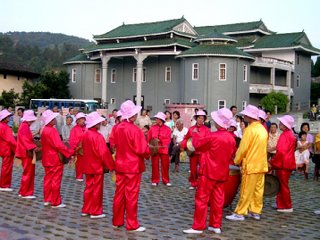



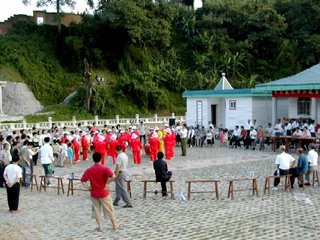

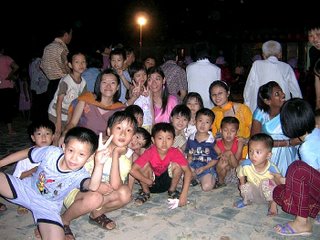
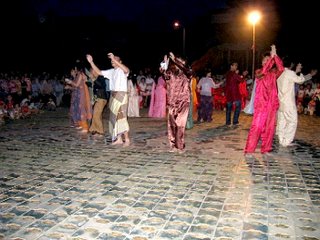
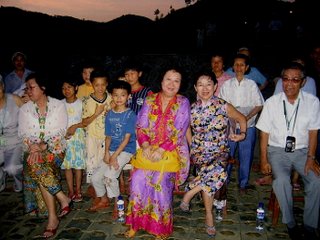
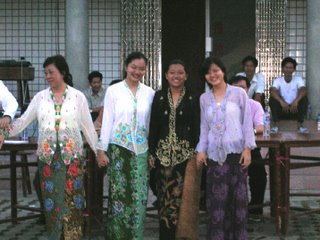


We returned to our "Tulou Hotel" at about 9.30pm. Most of us elderly members retired to our rooms early. As the young ones were still full of energy, the place was not quiet until well after midnight.
My room was hot and stuffy but as I used to sleep on planks without mattress in my younger days, I managed to sleep well. I was tired anyway.
I was awakened early in the morning by roosters crowing and thrushes singing lustily. I enjoyed listening to these birds breaking the morning silence.. They reminded me of the two years on a vegetable farm during the Japanese Occupation.
After breakfast, we went to Zhongchuan Village again. Besides visiting Aw Boon Haw ( Tiger Balm King) Memorial Hall, we also visited homes of some local residents to learn first hand how they lived their lives in such a mountainous region so far away from the city.
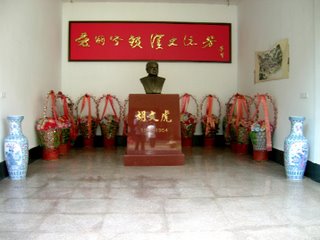



We left the Hakka village for Xiamen after lunch and arrived in the city at about 7.00pm.


I think the Tulou experience is good for our youths. On hindsight, however, I think the organisers should have given us seniors better accommodation. Why? Well, we had already gone through a lot of rough-and- tough life experiences. Do you still need to train oldsters like us to become tougher? Besides, most of us were already in our 60s and 70s, the oldest 76. And those with painful knees (osteoarthritis) found climbing up and down two or three flights of steep wooden staircase a torture. I think the organisers had only the youths in mind most of the time when planning the trip. The idea was to toughen up these future leaders. But they forgot that the awardees of the Life Inspiration Award were senior citizens, some of whom in their 70s and having knee problems. They were given the award because of their outstanding community service. So was it necessary that they should also be toughened up?
It is easier to organise group activities for either the young or the old, but much harder for both the young as well as the old.
Note: Videos showing our visits to Xiamen and Hakka Tulou are available.
To view them, please click the links below:
1. To Xiamen
2. To Hakka Tulou 客家土楼
3. Xiamen - More Places to Visit













0 Comments:
Post a Comment
Subscribe to Post Comments [Atom]
<< Home